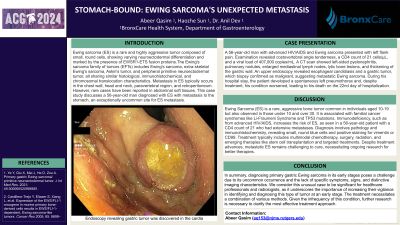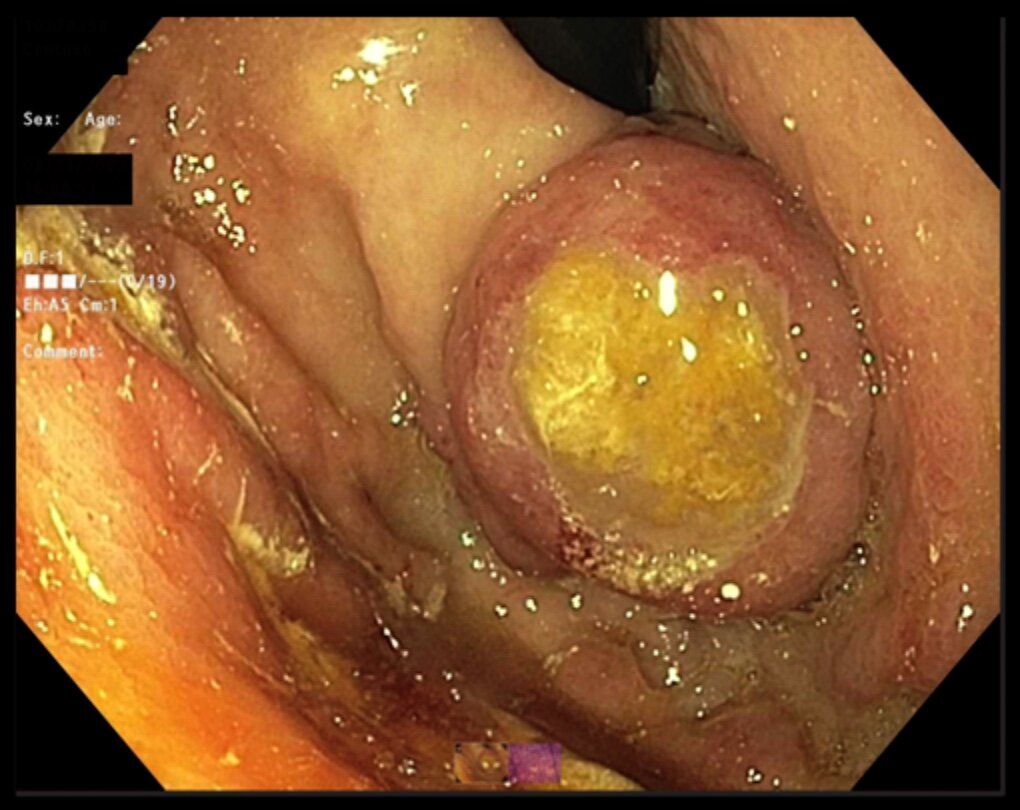Sunday Poster Session
Category: Stomach
P1629 - Stomach-Bound: Ewing Sarcoma's Unexpected Metastasis
Sunday, October 27, 2024
3:30 PM - 7:00 PM ET
Location: Exhibit Hall E

Has Audio

Abeer Qasim, MD
BronxCare Health System
Bronx, NY
Presenting Author(s)
Abeer Qasim, , Haozhe Sun, MD, Anil Dev, MD
BronxCare Health System, Bronx, NY
Introduction: Ewing sarcoma (ES) is a rare and highly aggressive tumor composed of small, round cells, showing varying neuroectodermal differentiation and marked by the presence of EWSR1-ETS fusion proteins.The Ewing's sarcoma family of tumors (EFTs) includes Ewing's sarcoma, extra-skeletal Ewing's sarcoma, Askin's tumor, and peripheral primitive neuroectodermal tumor, all sharing similar histological, immunohistochemical, and chromosomal translocation characteristics.Metastasis in ES typically occurs in the chest wall, head and neck, paravertebral region, and retroperitoneum. However, rare cases have been reported in abdominal soft tissues. This case study discusses a 56-year-old man diagnosed with ES with metastasis to the stomach, an exceptionally uncommon site for ES metastasis.
Case Description/Methods: A 56-year-old man with advanced HIV/AIDS and Ewing sarcoma presented with left flank pain. Examination revealed costovertebral angle tenderness, a CD4 count of 21 cells/µL, and a viral load of 407,000 copies/mL. A CT scan showed left-sided pyelonephritis, pulmonary nodules, enlarged mediastinal lymph nodes, lytic bone lesions, and thickening of the gastric wall. An upper endoscopy revealed esophageal candidiasis and a gastric tumor, which biopsy confirmed as malignant, suggesting metastatic Ewing sarcoma. During his hospital stay, the patient developed a spontaneous left pneumothorax and, despite treatment, his condition worsened, leading to his death on the 22nd day of hospitalization.
Discussion:

Disclosures:
Abeer Qasim, , Haozhe Sun, MD, Anil Dev, MD. P1629 - Stomach-Bound: Ewing Sarcoma's Unexpected Metastasis, ACG 2024 Annual Scientific Meeting Abstracts. Philadelphia, PA: American College of Gastroenterology.
BronxCare Health System, Bronx, NY
Introduction: Ewing sarcoma (ES) is a rare and highly aggressive tumor composed of small, round cells, showing varying neuroectodermal differentiation and marked by the presence of EWSR1-ETS fusion proteins.The Ewing's sarcoma family of tumors (EFTs) includes Ewing's sarcoma, extra-skeletal Ewing's sarcoma, Askin's tumor, and peripheral primitive neuroectodermal tumor, all sharing similar histological, immunohistochemical, and chromosomal translocation characteristics.Metastasis in ES typically occurs in the chest wall, head and neck, paravertebral region, and retroperitoneum. However, rare cases have been reported in abdominal soft tissues. This case study discusses a 56-year-old man diagnosed with ES with metastasis to the stomach, an exceptionally uncommon site for ES metastasis.
Case Description/Methods: A 56-year-old man with advanced HIV/AIDS and Ewing sarcoma presented with left flank pain. Examination revealed costovertebral angle tenderness, a CD4 count of 21 cells/µL, and a viral load of 407,000 copies/mL. A CT scan showed left-sided pyelonephritis, pulmonary nodules, enlarged mediastinal lymph nodes, lytic bone lesions, and thickening of the gastric wall. An upper endoscopy revealed esophageal candidiasis and a gastric tumor, which biopsy confirmed as malignant, suggesting metastatic Ewing sarcoma. During his hospital stay, the patient developed a spontaneous left pneumothorax and, despite treatment, his condition worsened, leading to his death on the 22nd day of hospitalization.
Discussion:

Figure: endoscopy revealing gastric tumor was discovered in the cardia.
Disclosures:
Abeer Qasim indicated no relevant financial relationships.
Haozhe Sun indicated no relevant financial relationships.
Anil Dev indicated no relevant financial relationships.
Abeer Qasim, , Haozhe Sun, MD, Anil Dev, MD. P1629 - Stomach-Bound: Ewing Sarcoma's Unexpected Metastasis, ACG 2024 Annual Scientific Meeting Abstracts. Philadelphia, PA: American College of Gastroenterology.
